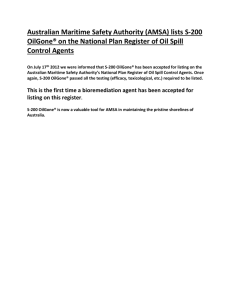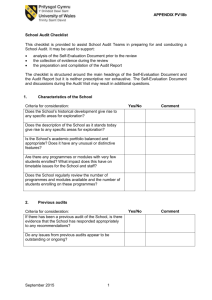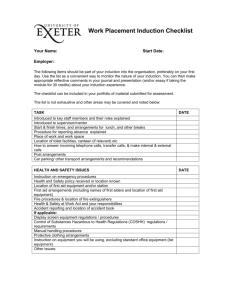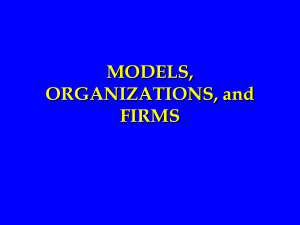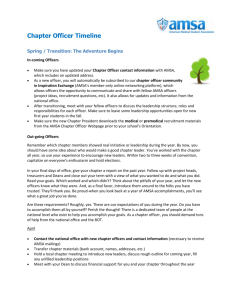S002-Submission
advertisement
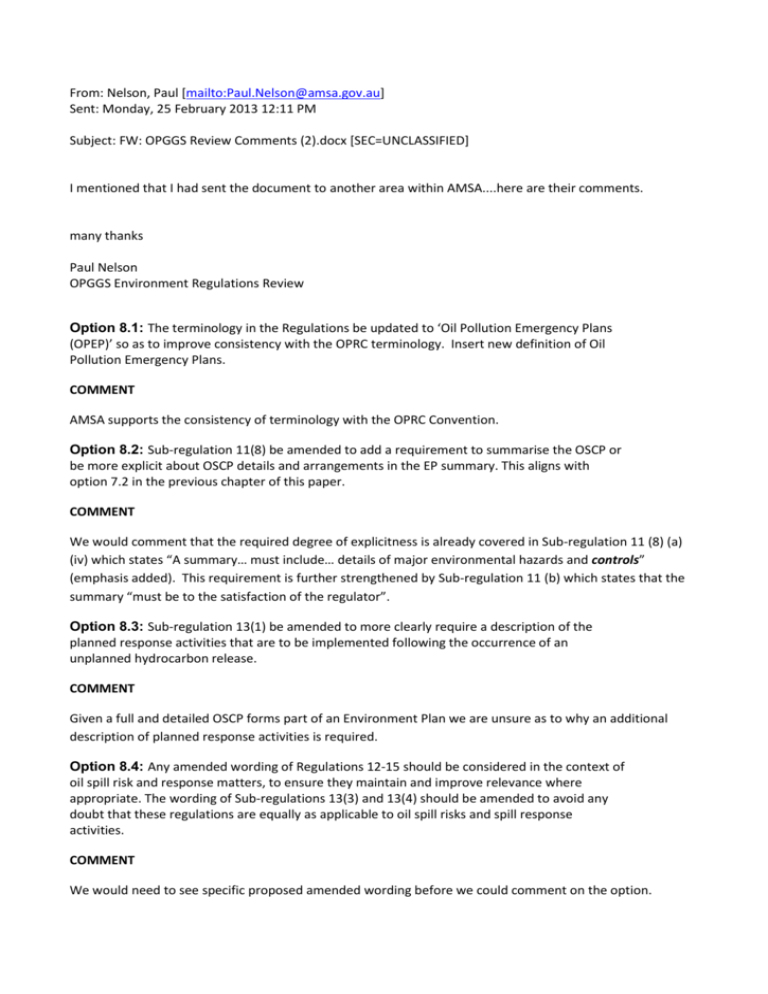
From: Nelson, Paul [mailto:Paul.Nelson@amsa.gov.au] Sent: Monday, 25 February 2013 12:11 PM Subject: FW: OPGGS Review Comments (2).docx [SEC=UNCLASSIFIED] I mentioned that I had sent the document to another area within AMSA....here are their comments. many thanks Paul Nelson OPGGS Environment Regulations Review Option 8.1: The terminology in the Regulations be updated to ‘Oil Pollution Emergency Plans (OPEP)’ so as to improve consistency with the OPRC terminology. Insert new definition of Oil Pollution Emergency Plans. COMMENT AMSA supports the consistency of terminology with the OPRC Convention. Option 8.2: Sub‐regulation 11(8) be amended to add a requirement to summarise the OSCP or be more explicit about OSCP details and arrangements in the EP summary. This aligns with option 7.2 in the previous chapter of this paper. COMMENT We would comment that the required degree of explicitness is already covered in Sub-regulation 11 (8) (a) (iv) which states “A summary… must include… details of major environmental hazards and controls” (emphasis added). This requirement is further strengthened by Sub-regulation 11 (b) which states that the summary “must be to the satisfaction of the regulator”. Option 8.3: Sub‐regulation 13(1) be amended to more clearly require a description of the planned response activities that are to be implemented following the occurrence of an unplanned hydrocarbon release. COMMENT Given a full and detailed OSCP forms part of an Environment Plan we are unsure as to why an additional description of planned response activities is required. Option 8.4: Any amended wording of Regulations 12‐15 should be considered in the context of oil spill risk and response matters, to ensure they maintain and improve relevance where appropriate. The wording of Sub‐regulations 13(3) and 13(4) should be amended to avoid any doubt that these regulations are equally as applicable to oil spill risks and spill response activities. COMMENT We would need to see specific proposed amended wording before we could comment on the option. The linking of performance objectives and standards to the management of unplanned marine environment emergencies is problematic and may cause conflict with other standards e.g. WH&S requirements etc. Similarly the performance of the operator in protecting the environment can be affected by factors outside their control e.g. weather, currents, tides etc. The National Plan recognises this fact and therefore does not include performance objectives and standards. Specific response objectives are formulated in response to an incident once it has occurred (the Incident Action Plan). It would not be desirable to have an operator endeavouring to meet a predetermined objective which was inappropriate e.g. responding with capture and recovery activities and their associated hazards when a monitor and observe strategy is all that is required. Option 8.5: Sub‐regulations 14(8AA) and 14(8A) which define the requirements for OSCPs elaborate on the ‘response arrangements’ to be addressed within the submission by explicitly requiring that submissions describe: a) the operational response activities to be implemented for the range of credible scenarios defined within the risk assessment; b) the preparedness arrangements to ensure a response capability is in place and is maintained; c) consistency with the national framework for oil spill response; and d) arrangements in place to control the source of a potential hydrocarbon spill in the event of an emergency. The details of these arrangements would be required content of the OPEP, but where this content is to be provided would not specified. The amendments to Sub‐regulations 14(8) and 14(8AA) would reflect that the OPEP is an operational response document, and accordingly the relevant evaluations, justifications and demonstrations of preparedness are to be provided elsewhere in the EP. COMMENT We agree there is benefit in maintaining the OSCP as an operational level document. Justification for proposed response arrangements is unnecessary in such documents if recorded as appropriate treatments in a comprehensive risk assessment process. While on the subject of risk assessment, we note that the regulations and guidance to industry do not make reference to the International Standard for Risk Management (ISO AS/NZS 31000:2009). Similarly, many of the terms contained in the regulations and guidance are not commonly in use in Risk Management practice e.g. ‘as low as reasonably possible (ALARP)’. As an example, the three possible responses to the appearance of risk are: elimination, mitigation (treatment), or acceptance. Residual Risk (the risk remaining after mitigation) is generally described in terms of acceptability rather than ALARP. Acceptable risk normally involves a compromise between the complete elimination of the risk and the cost of applying the treatments to achieve this state. Under the current wording of the OPGGS (Environment) Regulations it is possible that application of a treatment may not lower the risk of a given event occurring at all. This is where the use of terms like ALARP can be misleading as it is possible that the chance of a risk escalating to an actual incident may be ALARP but still unacceptably high to either the risk owner or those that it may impact. As such the Sub-regulations regarding evaluations and justifications should reference and adopt the terminology of the International Standard for Risk Management. Option 8.6: The OPEP to include arrangements for monitoring of response efficacy and the impacts on the receiving environment appropriate to the credible spill scenarios defined for the activity. With respect to environmental monitoring, response arrangements should include: a) Operational monitoring to inform the response activities; and b) Scientific monitoring for environmental damage assessment including extent, severity and duration and arrangements for baseline studies. COMMENT We consider these activities to be a standard part of any organised response. These activities would normally be undertaken as part of a review (often daily) of the Incident Action Plan. It might be necessary for scientific monitoring to continue for an extensive period after the operational phase has been completed. Option 8.7: Sub‐regulation 14(8A) should be updated to clarify the intent of the Regulation. The Regulations should ensure that the oil spill response arrangements are tested and the objectives of the test: a) assess the elements of response relevant to notification, communications, responsibilities, mobilisation and response operations. b) demonstrate that the operator is adequately prepared to respond to a spill and mitigate impacts of a spill to ALARP. COMMENT See previous comments on use of ALARP as a measure of residual risk and application of the International Standard for Risk Management. Option 8.8: Sub‐regulation 14(8) to require that the response arrangements described in the OPEP are relevant and commensurate to the nature and scale of the range of credible spill scenarios evaluated in Sub‐regulations 13(3) and 13(3A). COMMENT This option also proposes a process which would be a normal output of a comprehensive risk management process. Option 8.9: The EP is required to detail the arrangements in place for insurance, cost‐recovery and other financial liabilities associated with impacts to the environment and remediation of those impacts to the environment, and include an independent validation of necessary insurance or financial capacity, commensurate to the risks of the activity. COMMENT Agreed, assuming the risks of the activity have been appropriately identified. Option 8.10: If specific content requirements of the ‘response arrangements’ are not amended into the Regulations, then the regulation could be amended to clarify that the response arrangements are described to the satisfaction of the Regulator. This would then provide further opportunity for the Regulator to elaborate on these requirements within guidance. COMMENT As per Option 8.2 above the required degree of explicitness is already covered in Sub-regulation 11 (8) (a) (iv) which states “A summary… must include… details of major environmental hazards and controls” (emphasis added). This requirement is further strengthened by Sub-regulation 11 (b) which states that the summary “must be to the satisfaction of the regulator”. Option 8.11: Insert a new regulation to enable the Regulator to call a no‐notice real‐time spill response exercise requiring the operator to respond accordingly and deploy to a level directed by the Regulator and report back to the Regulator on completion. COMMENT AMSA encourages the usage of terminology other than ‘exercise’ to describe the concept outlined in Option 8.11. An exercise in emergency management terms and as understood within the National Plan is a controlled, objective-driven activity designed to practice, evaluate and test processes and capabilities. An essential part of an exercise is that the objectives are pre-agreed between all parties and the outcomes jointly evaluated to improve the contingency plan and supporting arrangements. In the view of AMSA exercises are not a tool for regulatory compliance. AMSA believes that that the activity described in Option 8.11 is more appropriately an unannounced audit. This terminology is employed to describe unannounced activations of AMSA response contractors to test their ability to deliver on contracted services. AMSA is also concerned that Option 8.11 is being proposed without an evaluation of the cost to the regulator, companies and associated Government agencies. AMSA’s experience is that the development of a full deployment exercise requires several months of planning from dedicated team to ensure that the proper controls are in place to manage the exercise and the associated risks (in particular health and safety). In addition the correct evaluation of an exercise requires umpires in the field as well as a control team established close to the exercise scene to ensure the exercise of performed safely. The costs associated with this work is substantial and does not take account of any costs imposed on a company should they be required to defer work due to the exercise conduct. AMSA also notes that Option 8.11 is silent on which parties would be involved in such capability audits. AMSA, as a party to a number of offshore industry oil spill contingency plans would not agree to be participating in these activities as the costs imposed on normal business would significantly outweigh any benefits of participation. Option 8.12: For consistency, the term ‘remediate’ be used in reference to the response arrangements required by Sub‐regulation 14(8AA) and the term be defined within the Regulations. COMMENT Agreed.


